Facts About Great spotted woodpecker
The great spotted woodpecker is a striking medium-sized bird, easily recognized by its black and white plumage and distinctive red patch on its lower belly. These birds are prevalent across the Palearctic region, which includes parts of North Africa. Known for their unique behavior of chiseling into trees to find food and create nesting sites, their drumming is not merely for show—it serves as a means to communicate territorial boundaries to other woodpeckers. These birds have evolved specialized adaptations to withstand the physical stress of continuous hammering.
As omnivores, great spotted woodpeckers have a varied diet that includes seeds, insect larvae, and even eggs. During the breeding season, they nest in tree cavities and typically lay four to six eggs. Both parents share the responsibility of caring for the young until they are ready to fledge.
In terms of classification, the great spotted woodpecker belongs to the genus Dendrocopos and has several subspecies, some of which may even constitute distinct species. These birds are widespread across Eurasia and North Africa, thriving in various types of woodlands and even altered habitats. While they are generally sedentary, they may migrate if food becomes scarce. Currently, they face no major threats and are listed as "Least Concern" by the IUCN.
These woodpeckers are quite territorial and form monogamous pairs during the breeding season. They possess remarkable adaptations for climbing trees, such as specialized features to cushion the impact of their drumming and pecking. Despite their prowess, they do have natural predators, including woodland birds of prey, and they can host various parasites.

 Ireland
Ireland